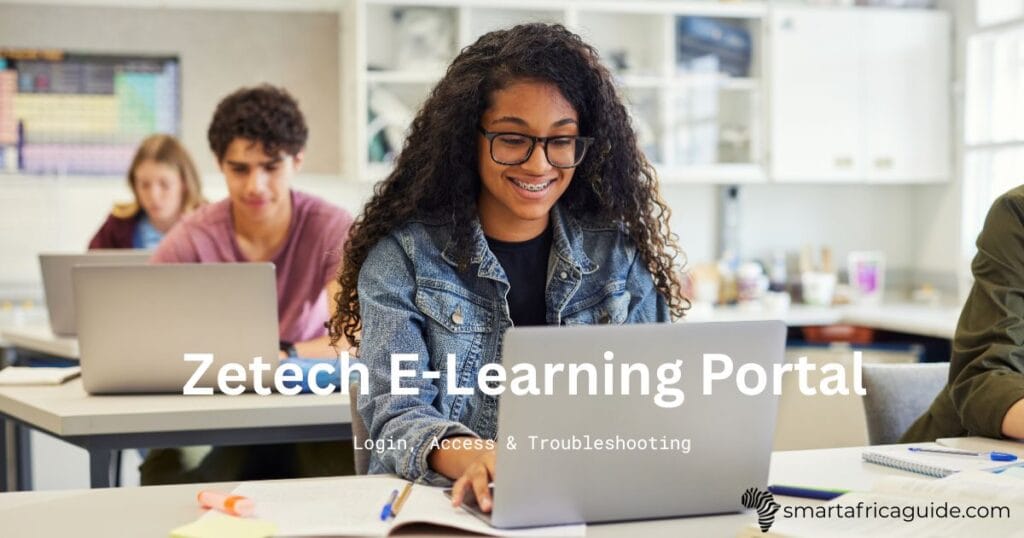E-learning in Kenya is growing fast across universities and homes.
It was sometime after 10 at night when I opened that WhatsApp message. I was not really looking for anything serious, but I was just scrolling. I clicked the video just to see what it was, nothing serious. The video started, and I figured I would only watch a few seconds. But somehow, I sat through the whole lecture without even planning to. Looking back, that was the first time I truly experienced e learning, and it quietly changed how I saw the idea of studying.
Across Kenya, more people are now learning this way. From university students logging into their portals to parents downloading apps for their children, e-learning is becoming part of everyday life. You do not need a fancy laptop or a perfect setup. If you have a phone and a little curiosity, you can begin.
In this article, I am going to walk you through 7 crucial ways to commence with e-learning in Kenya – simple, practical ideas that anyone can try, no matter where they are starting from. – brainstorming concepts that anyone can try, no matter where they are starting from.
Quick Answers
What is e-learning in Kenya?
E-learning in Kenya means studying through online platforms or apps instead of traditional classrooms. It includes university portals, mobile courses, and recorded lessons that help students and professionals learn anywhere with internet access.
How can someone start e-learning in Kenya?
Start by using your university portal or a free online course site like Coursera or ALX Africa. With a phone, stable connection, and consistency, you can learn new subjects or skills from home.
What is the benefit of e-learning?
It allows flexible study hours, saves travel costs, and gives access to expert teachers across the world. Students can replay lessons, complete assignments, and learn at their own pace.
Is e-learning suitable for people without laptops?
Yes. Most Kenyan universities support mobile-friendly portals and apps. Learners can use phones with data-saving mode and offline downloads to continue studying easily.
Table of Contents
Definition of E-Learning

In layman’s terms, the learning that takes place via electronic means is referred to as e-learning. It could be a recorded lecture, an online quiz, or even a live Zoom class. It covers both formal and informal ways of gaining knowledge using technology.
You will find it in universities, where students submit assignments online. In offices, new hires go through digital onboarding, even in coding bootcamps and mobile apps teaching Swahili.
If you have ever watched a tutorial on your phone, joined a WhatsApp study group, or logged into a school portal, then you already know a bit about e-learning. Still, people have questions like how e-learning is useful to us, and the answer to this question is straightforward.
At its core, e-learning helps people:
- Learn at their own pace
- Teach across distances
- Upskill without needing a classroom
There is absolutely zero need to be a tech expert to make the most out of it. Begin wherever you like, with an open mind, to explore new and uncharted ideas.
7 Key Ways to Get Started with E-Learning in Kenya
#1. Use University E-Learning Portals
Have you ever tried logging into your university’s portal the night before an exam, only to find it crawling like a matatu stuck in traffic? That is the reality for many students in Kenya. Yes, they frustrate you sometimes, but without them, most universities would be completely stuck. They really are holding higher education together now.
Honestly, the portal is just like a door you keep opening. Type in your ID, hit enter, and there it all is – lectures, assignments, group chats, and that one grade that refuses to leave your mind. Most universities now depend on this system.
Here are a few that students frequently mention:
Popular Kenya Portals:
| University | Portal URL | Typical Login Path | Help Page |
| Zetech University | https://portal.zetech.ac.ke/ | Student login → courses | Helpdesk (you can also check our article for assistance) |
| MKU | https://vlms.mku.ac.ke/ | Login → dashboard | FAQ page |
| Kisii University | https://elearning.kisiiuniversity.ac.ke/ | Portal login | IT support |
| Egerton University | https://studentportal.egerton.ac.ke/ | Sign in → e-classroom | Help line |
| Maseno University | https://elearning.maseno.ac.ke/ | Student login | Guides |
In case the login doesn’t work, there is no need to panic. Most of the time, it can be attributed to things like a wrong password or a cache that needs clearing. And when those tricks fail, the IT desk becomes your last stop. They usually sort it out, but you may need some patience while waiting.
Using an e-learning student portal is often the first step toward digital learning in Kenya.
#2. Take Advantage of Online Courses & MOOCs
You do not need to walk into a classroom to learn something new anymore. These days, many Kenyans are discovering that you can pick up real skills—sometimes even job-ready ones, just by going online. And the best part? Some of these courses are completely free of charge.
MOOCs (Massive Open Online Courses) are everywhere now. Sites like Coursera and Udemy have thousands of topics, from business to graphic design. If you’re short on cash, the Kenya Education Cloud has solid local content. Platforms such as ALX Africa are assisting young professionals in building their careers in tech without requiring a degree.
But before we move ahead, there is a question that you might be having: what do you want to learn, and why? There are certain online courses that come with certificates that help you get the desired jobs. While other courses are more casual, you never know when they will come in handy in your professional career.
A few things to check before enrolling:
- Does the course offer a certificate at the end?
- Can you audit it for free?
- Does it have a mobile app? Can you download the content to save bundles?
A student in Kisumu could be learning Python from a Harvard professor. A mother in Meru might be taking an online bookkeeping course between chores. That’s the beauty of it. You start where you are.
#3. Learn Through Mobile Apps & Social Media
Have you ever saved a YouTube playlist thinking you’d watch it later, and then actually learned something useful from it? That’s e-learning too. And it’s happening more than people think.
In Kenya, mobile phones are everywhere. From WhatsApp groups sharing KCSE notes to Telegram channels packed with university past papers, social media has become an informal learning space. You do not need a laptop or fancy software. Your phone is enough.
The crucial part is being aware of where to search and what to overlook. Not every video or PDF shared online is helpful. Some are outdated. Others are just wrong.
Here’s what smart learners do:
- They follow verified educators or institutions on YouTube and Telegram
- They save useful videos when bundles are cheap
- They use data caps or Wi-Fi to avoid surprise airtime losses
Apps like Duolingo, Khan Academy, and even TikTok (believe it or not) have educational content too. If used right, your scrolling time can turn into study time. And no, you do not need to be a “techie.” You just need to be curious.
#4. Blend E-Learning with Classroom Learning

Sometimes, the best way to learn is by mixing the old with the new. Kenyan universities have caught onto this, and that’s where blended learning comes in.
So, what is e-learning in education when blended? It means you still attend some lectures in person, but you also study through online platforms. You revise notes on your portal, take digital quizzes, or watch a recorded lesson at night when it’s quieter.
Picture a typical week for a university student in Nairobi:
| Day of the week | Activities to be Performed |
| Monday | Show up for class, take notes |
| Tuesday | Log into the portal, revisit the slides |
| Wednesday | Submit a quiz online |
| Thursday | Work on a group project in person |
| Friday | Make pertinent changes with the help of YouTube videos shared in the WhatsApp group |
With such a schedule, you can get the most, especially when you are juggling between part-time jobs, family duties, or long commutes. This will help you choose your time according to your own availability so that you do not miss out on anything discussed in the classroom.
And when the internet cuts out or the LMS crashes? No need for panic; you still have the classroom to fall back on.
#5. Explore E-Learning for Business & Work
If you have ever sat through a staff training session in a boardroom while someone read off a PowerPoint, you know it is not the best way to learn. Kenyan businesses are catching on to this and moving online.
So what is e-learning in business? It’s how companies now train their teams using digital tools. Banks are doing it for compliance. Startups use it for onboarding. Retail chains use it to train new hires fast.
A shop manager in Eldoret might complete an online customer service module on their phone. An HR officer in Nairobi might assign e-learning paths to interns using a basic LMS.
Why it works:
- It’s cheaper than physical workshops
- You can track who actually completed the course
- Staff learn at their own pace, not just when there’s a scheduled seminar
If you run a small business, you do not need fancy systems. Even a private YouTube video or Google Drive folder with tutorials can be a solid start. Whether your team is three people or 300, digital training is no longer optional; it’s the smart way forward.
#6. Create Your Own E-Learning Materials
Now here’s a question more people should ask: what if I created my own course?
You do not need to be an expert in everything. But if you know something useful, how to use Excel, how to cook on a budget, how to do basic bookkeeping, you can teach it. That’s how many e-learning businesses start.
So, how to create e-learning materials? You can start with:
- Slides (PowerPoint or Canva works)
- Screen recording tools like Loom
- Quizzes via Google Forms or Moodle
- Upload everything to YouTube, a portal, or even WhatsApp
And don’t worry about being “too simple.” Simple is good. People do not want lectures—they want clarity.
Checklist before you share your first course:
- Did you break the content into clear steps?
- Is your voice or explanation easy to follow?
- Have you tested the quiz or file link?
- Can someone complete your lesson without getting confused?
If you are thinking about how to start an e-learning business, this is your first step. Start small. Be honest. And teach something you know well.
#7. Follow E-Learning Tech Trends in Kenya

There is a lot changing in the country, and at a rapid pace. If you seriously want to take advantage of this digital learning trend, the best thing is to closely watch over the next big trend coming up in e-learning. That’s where e-learning technology comes in.
First-ODeL (Open, Distance and E-Learning) centers are growing across public universities. More government initiatives are pushing digital access. 5G is expanding in major towns. This is not just a phase; it’s the direction Kenya is heading.
Here are a few trends that are making noise in Kenya
- Proctoring tools so that there is zero scope for cheating during online exams
- Interactive content like quizzes, games, and simulations
- AI tutors provide personalized feedback when you want it the most
- People are opting for offline learning modes, especially when they reside in low-data environments
As a student residing in rural areas, offline options can prove to be Godsent to help you progress well in your academic life, which will ultimately help you in your professional life.
You download your course material when you have Wi-Fi, then study later without needing data.
If you are an educator or entrepreneur, staying updated gives you an edge. You can ride the wave, not get left behind.
Common Problems and Quick Fixes
Let’s be honest. E-learning does not always work smoothly. Portals freeze. Videos do not load. Logins fail at the worst time, usually when something is due.
Here’s a quick table that might help:
| Problem | Likely Cause | Quick Fix | Who to Contact |
| Can’t log in | Wrong Password or cache | Reset password, clear browser | IT support |
| Courses not showing | Enrollment not complete | Re-check registration status | Department head |
| Video won’t load | Poor network/data issues | Download during off-peak hours | Use offline mode |
| Site is slow/down | Server problems | Wait or switch to mobile view | University admin |
One more tip? Always take screenshots when something fails. It makes explaining the issue easier when you finally reach IT support.
Popular Kenya E-Learning Portals

You have probably heard of at least one of these if you have studied in Kenya recently:
- JOOUST – Tech-friendly for science and research courses
- Egerton University – Offers lecture notes, past papers, and more
- Maseno University – Pioneer of ODeL in Kenya
- Machakos University – Expanding rural access to online content
- Zetech University – Easy-to-navigate and dependable portal
- TMU – Perfect for hands-on vocational and technical programs
- MKU (Mount Kenya University) – One of the most used e-learning portals in the country
- Kisii University – Combines blended learning with strong online support
- KIM (Kenya Institute of Management) – Great for professionals
- MMUST – Strong ODeL platform for remote learning
Each of these universities offers a working LMS platform. Check if your school is on the list and try logging in today.
Frequently Asked Questions
1. Define e-learning in layman’s terms.
It is just learning through your phone, laptop, or computer. Could be a video lesson, a portal, or even a quiz online. If you are learning something through the internet, that’s e-learning. Simple as that.
2. What is e-learning in education?
It is when schools or universities mix classroom learning with online platforms. You go to class, then log in later for notes, assignments, or even a quiz.
3. What is e-learning in business?
It’s how companies train their staff online. No more workshops. Just short modules, videos, or slides that employees can complete from anywhere, even on their phones.
4. What is e-learning in computers and technology?
This is when tech tools help deliver lessons, such as recorded videos, slides, screen sharing, or LMS portals. Even Google Forms quizzes count.
5. How do I start e-learning?
Pick one topic. Just one. Search for a platform that suits your requirements. It can be a university portal or Coursera. Next, follow your routine religiously and observe your growth over time.
6. How do I sign in to an e-learning portal?
Go to the portal’s site, type your student ID and password. If it fails, try resetting or clearing your browser. Still stuck? Call IT. They deal with this every day.
7. How do you create e-learning materials?
Start small. Use slides, record your screen, and explain clearly, then add a quiz. Tools like Loom, Google Forms, and PowerPoint are enough to get going.
8. How do I start an e-learning business?
Teach whatever field you are an expert in. Record lessons and then upload them to YouTube or the course site. Finally, share them. This will help you grow slowly. The best teachers often commence with just a phone.
9. Can you explain e-learning with examples?
A student watches a math video. A worker completes online training. A teen joins a language class on Zoom. That is all e-learning.
10. How is social media used in e-learning?
WhatsApp groups, YouTube tutorials, and Telegram channels are everywhere. Just be smart. Follow good sources and avoid distractions.
Conclusion
E-learning in Kenya is no longer something that only happens in big cities or expensive private schools. It is happening everywhere, from mobile phones in rural towns to busy offices in Nairobi. Whether you are using a university e-learning portal, a mobile app, or watching free videos, the most important step is just to begin.
In this article, we covered seven practical ways to get started, including portals, MOOCs, social media, and creating your own content.
The opportunities are out there, and they are growing every day. Start small.
For more learning opportunities, explore scholarships and online programs on SmartAfricaGuide.
Disclaimer: This guide summarizes general e-learning information in Kenya. Policy and portal changes may occur. Always confirm current details on official Ministry of Education or KUCCPS websites.

Varsha Asrani is a lecturer and education writer with experience as Visiting Faculty at AUPP and ATMC College, and as a Lecturer with TalentEdge and UpGrad. She is the Founder of the Asrani Institute of Education and Counselling. Varsha specializes in scholarships, e-learning, and career guidance for African students and professionals, and regularly visits Africa to gather first-hand insights that shape her research and articles.




Pingback: Why Do the Legs on a Head Frame Always Slope Toward the Winch? The Ingenious Design
Pingback: SANRAL Scholarship South Africa | Eligibility, Benefits, and Application Guide
Pingback: 7 Proven Steps to Win the Allan Gray Scholarship